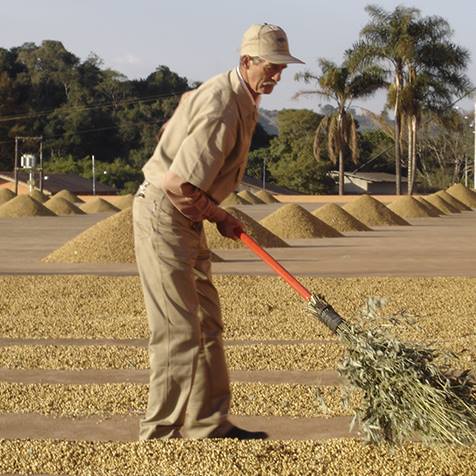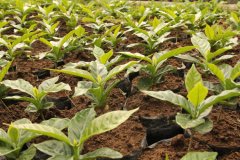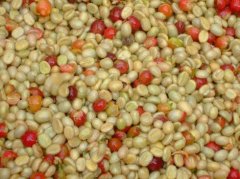Introduction to Kagomoini Manor, Kenya Coffee Manor, which must be visited by European bean merchants.
For professional baristas, please follow the coffee workshop (Wechat official account cafe_style)

Kenya AA- Kagomoini Manor beans
Kenya, the giant in the coffee market is also a model country for producing fine coffee beans. The Arabica natural washing beans produced in Kenya are the top coffee beans in the world. Most of the coffee beans are graded by the Kenya Coffee Bureau and sold at auction. Kenya Coffee Agency's research, development and quality management of coffee is meticulous. Raise the price of coffee beans through an excellent auction system to help hard-working coffee farmers and through education to update the knowledge of brown farmers to further improve the production of better coffee.
Kagomoini Manor, which is harvested in the new season, is an alpine farm located south of Mount Central Kenya. More than 1650 meters above sea level, it is a small coffee farm with low output. The coffee farm has a variety of wild animals and unman-made primitive ecology. It is a must for many European bean merchants to look for coffee beans.
Compared with other Kenyan coffee, citrus acid is weaker, but the taste is smooth, but sour to sweet and slow and delicate compared to other Kenyan coffee. The proportion of defective beans selected carefully by hand is about 3%, the weight loss ratio of roasted to light baked (city) coffee beans is 14%, and the proportion of empty shell beans to bad beans is 4%, because the sour gas during the drying period is very low and fruity (the proportion of coffee bean body expansion is high), properly extend the drying time to adopt a more moderate temperature rise curve to retain more aroma and sweetness and reduce acidity. These are beloved Kenyan beans (not sour).

Shallow baked City (fragrance): imported grapefruit has strong acidity, rich and complex acidity, scented tea aromas of cherry oranges and chamomile, and saliva gushing out of the mouth with the aroma of grapefruit.
Medium baking (general B): the aroma of jasmine tea is very bright, the citrus acid is weak and has the characteristics of orange water so that you will not take a breath, the taste is thin, smooth and layered, and the finish is a very typical sweet taste of yellow and orange ripe fruit. The baking degree has already produced the oil esterified taste, and the acid will mask the sweet and gentle taste.
Re-roasting (general C): after the coffee is roasted to the end of the explosion, the heating curve can make the re-baking a little different, the aroma is a little more lively and a little more caramel, but to avoid bitterness and slow heating is mainly to completely remove sour and astringent, increase the sweetness of maltose or brown sugar to avoid inactive aroma, generally adopt the middle heating method to give him the aroma of nutty hazelnut. The sweetness and complexity of maltose or brown sugar with a touch of oil ester and fruity aroma.
Roasted to a deeper roasting (Full-City+ or dark), the coffee bean surface shows a spot of oil, which is the most suitable for re-roasting except Mantenin, mainly from the fact that both coffee beans have a very strong taste during heavy roasting, and the aroma of chocolate is very sweet and pure.
Important Notice :
前街咖啡 FrontStreet Coffee has moved to new addredd:
FrontStreet Coffee Address: 315,Donghua East Road,GuangZhou
Tel:020 38364473
- Prev

Red Cherry Program improves coffee quality-Limu Kossa Cooperative Introduction
Professional barista exchanges, please pay attention to coffee workshop (Weixin Official Accounts cafe_style ) Ethiopian Red Cherry-Limu Kossa Sun-dried Beans Ethiopia is the first country where coffee was discovered. Nowadays, there are still many wild coffee in the virgin forest for farmers to gather and use. Ethiopia is a poor, drought and civil war country.
- Next

Kenyan guest Xi'an Winnie Manor Coffee beans are introduced in detail.
For the exchange of professional baristas, please follow the coffee workshop (Wechat official account cafe_style) Kenya Round Bean PB- guest Xi'an Winnie Manor Kenya, a giant in the coffee market, but also a model country for producing fine coffee, guest Xi'an Gethumbwini Estate Manor is its leading coffee farm. In 1957, the French company SOCFINAF owned Xi'an Winnie Manor.
Related
- Does Rose Summer choose Blue, Green or Red? Detailed explanation of Rose Summer Coffee plots and Classification in Panamanian Jade Manor
- What is the difference between the origin, producing area, processing plant, cooperative and manor of coffee beans?
- How fine does the espresso powder fit? how to grind the espresso?
- Sca coffee roasting degree color card coffee roasting degree 8 roasting color values what do you mean?
- The practice of lattes: how to make lattes at home
- Introduction to Indonesian Fine Coffee beans-- Java Coffee producing area of Indonesian Arabica Coffee
- How much will the flavor of light and medium roasted rose summer be expressed? What baking level is rose summer suitable for?
- Introduction to the characteristics of washing, sun-drying or wet-planing coffee commonly used in Mantenin, Indonesia
- Price characteristics of Arabica Coffee Bean Starbucks introduction to Manning Coffee Bean Taste producing area Variety Manor
- What is the authentic Yega flavor? What are the flavor characteristics of the really excellent Yejasuffi coffee beans?

